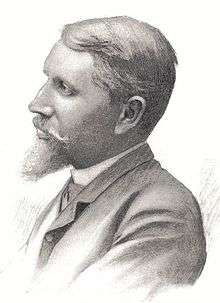Léo-Paul Robert
Léo-Paul Samuel Robert[1] (19 March 1851 - 10 September 1923), also known as Paul Robert, was a Swiss painter, known for his depictions of birds and other wildlife.
| Léo-Paul Robert | |
|---|---|
 | |
| Born | 19 March 1851 Biel/Bienne |
| Died | 10 October 1923 Orvin |
| Alma mater | |
| Occupation | Painter |
| Parent(s) |
|

Early life
Paul Robert was born in Biel/Bienne, Switzerland, on 19 March 1851, to Aurèle Robert ,[2] who, like his brother Louis Léopold Robert was a painter.
Paul trained under his father, and then, in 1869, at the Munich Academy of Arts.[2]
After the death of his father in December 1871, he visited Verona, Venice, Ravenna, Bologna and Florence.[2]
Career
After initially painting allegories, Robert turned his talents next to landscapes, and eventually to watercolours of birds and caterpillars.
His painting Zéphyrs d'un beau soir won a gold medal when exhibited at the Paris Salon in 1877.[3]
From 1886 to 1894, he was responsible for the decoration of the staircase at the Musée des beaux-arts de Neuchâtel (now the Musée d'Art et d'Histoire),[2] comprising three monumental murals; still extant.[4]
He illustrated an edition of Jeremias Gotthelf's 1842 book The Black Spider.[3]
From 1891 to 1897 he was a member of the Swiss Federal Commission of Fine Arts and from 1894 to 1918 of the Commission of the Gottfried Keller Foundation.[3]
In 1900 he made a mosaic mural in glass, "The Age of History", also extant, and featuring the figures of Poetry and History, for the facade of the Bern Historical Museum.[5]
Robert was also ordained as a minister in the protestant tradition.[3]
Legacy
Three of Robert's sons Théophile, Philippe and Paul-André were painters; Paul-André also painted nature subjects.[6]
Several of his works are in the Musée d'Art et d'Histoire at Neuchâtel.
The Neues Museum Biel houses the 3,000 works of the "Foundation Robert", [6] including hundreds by Paul, and others by the rest of his family.[7]
The street Paul-Robert-Weg[8] in Biel/Bienne is named in his honour.
Works illustrated
- Rambert, Eugene (1916). Les Oiseaux Dans La Nature.
References
- Sometimes written "Leo Paul"
- "Léo-Paul Robert, peintre suisse (1851-1923)" (in French). Archived from the original on 24 April 2019. Retrieved 24 April 2019.
- "1904 Léo-Paul-Samuel Robert Symbolist Painting - Woman w/ Long-necked Lute". Collectors Weekly. Retrieved 24 April 2019.
- "Léo-Paul ROBERT (Biel/Bienne , 1851 - Orvin, 1923)". Stephen Ongpin Fine Art. Retrieved 24 April 2019.
- "Exterior views". Bernisches Historisches Museum. Retrieved 24 April 2019.
- "Sammlung Stiftung Robert" (in German). Neues Museum Biel. Retrieved 24 April 2019.
- "NMB – RobLab". www.nmbiel.ch. Neues Museum Biel. Retrieved 24 April 2019.
- Coordinates for Paul-Robert-Weg: 47.15142°N 7.25682°E
Further reading
- Rivier, Louis (1927). Le peintre Paul Robert: l'homme, l'artiste et l'oeuvre, le novateur (in French). Neuchâtel: Delachaux & Niestlé.
- Jackson, Christine E. (2005). Les oiseaux et leur peintre : Léo-Paul Robert (in French). Bienne: Edition Fondation Collection Robert. ISBN 3-9522989-3-X.
- Ehrensperger, Ingrid; Girardin-Cestone, Lucie; Gschwend, Hanspeter (2006). Die Welt der Vögel - Werke von Leo-Paul und Paul-Andre Robert (in German). Biel: Bern u. Zürich, Benteli Verlag im Auftrag d. Stiftung Sammlung Robert. ISBN 9783716514016.
External links
| Wikimedia Commons has media related to Paul Robert. |